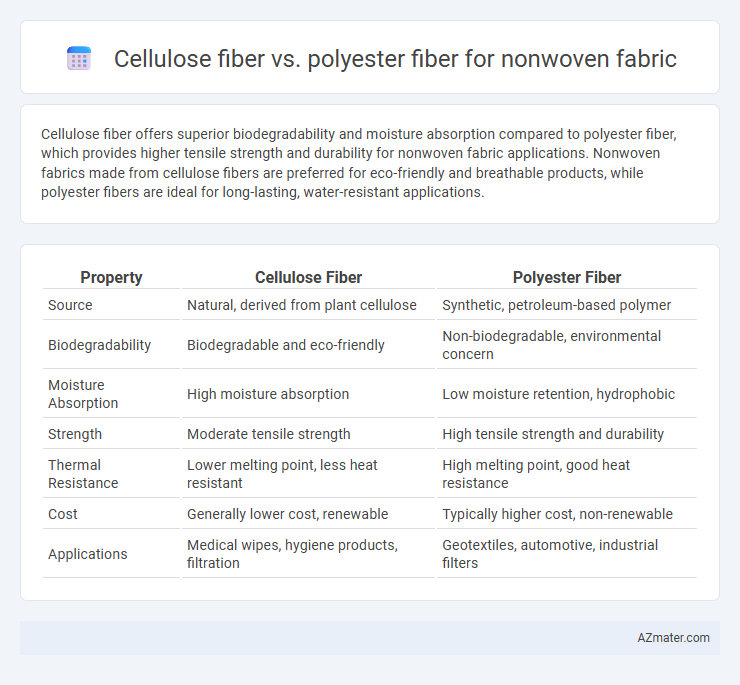Cellulose fiber offers superior biodegradability and moisture absorption compared to polyester fiber, which provides higher tensile strength and durability for nonwoven fabric applications. Nonwoven fabrics made from cellulose fibers are preferred for eco-friendly and breathable products, while polyester fibers are ideal for long-lasting, water-resistant applications.
Table of Comparison
| Property | Cellulose Fiber | Polyester Fiber |
|---|---|---|
| Source | Natural, derived from plant cellulose | Synthetic, petroleum-based polymer |
| Biodegradability | Biodegradable and eco-friendly | Non-biodegradable, environmental concern |
| Moisture Absorption | High moisture absorption | Low moisture retention, hydrophobic |
| Strength | Moderate tensile strength | High tensile strength and durability |
| Thermal Resistance | Lower melting point, less heat resistant | High melting point, good heat resistance |
| Cost | Generally lower cost, renewable | Typically higher cost, non-renewable |
| Applications | Medical wipes, hygiene products, filtration | Geotextiles, automotive, industrial filters |
Introduction to Nonwoven Fabrics
Nonwoven fabrics are engineered materials made from fibers bonded through mechanical, chemical, or thermal processes without weaving or knitting. Cellulose fiber, derived from natural sources like wood pulp, offers biodegradability, moisture absorption, and breathability, making it ideal for eco-friendly nonwovens. Polyester fiber, a synthetic polymer, provides strength, durability, and resistance to chemicals and moisture, frequently used in nonwovens for industrial applications and long-lasting products.
Overview of Cellulose Fiber
Cellulose fiber, derived from natural sources such as wood pulp and cotton, offers biodegradable and renewable properties making it an eco-friendly choice for nonwoven fabrics. It exhibits excellent moisture absorption and breathability, enhancing wearer comfort compared to synthetic alternatives. Cellulose fibers contribute to sustainable textile production by reducing reliance on petrochemical-based materials like polyester fiber.
Overview of Polyester Fiber
Polyester fiber, a synthetic polymer derived from petrochemical sources, offers exceptional strength, durability, and resistance to moisture and chemicals, making it ideal for nonwoven fabric applications. It provides high tensile strength and dimensional stability, resulting in products that maintain integrity under stress and resist shrinking or stretching. These properties make polyester fiber a preferred choice in medical textiles, filtration, and geotextiles where performance and longevity are critical.
Manufacturing Processes: Cellulose vs Polyester
Cellulose fibers for nonwoven fabric are derived from natural sources like wood pulp and undergo processes such as wet-laid or air-laid forming, where fibers are suspended in water or air before bonding by mechanical, chemical, or thermal means. Polyester fibers, in contrast, are synthetic polymers produced through melt spinning, where molten polymer is extruded and cooled into fibers, followed by processes like carding and needle punching or thermal bonding to form the fabric. Manufacturing cellulose-based nonwovens typically involves more energy-intensive drying and chemical treatments, whereas polyester nonwovens leverage continuous filament production allowing faster throughput and enhanced control over fiber properties.
Physical and Mechanical Properties Comparison
Cellulose fiber exhibits higher moisture absorbency and breathability compared to polyester fiber, making it suitable for applications requiring comfort and biodegradability in nonwoven fabrics. Polyester fiber offers superior tensile strength, durability, and resistance to chemicals and UV degradation, enhancing the mechanical performance and longevity of nonwoven materials. The blend of cellulose and polyester fibers can optimize physical properties by balancing moisture management with enhanced mechanical strength in nonwoven fabric production.
Environmental Impact and Sustainability
Cellulose fiber, derived from renewable natural sources like wood pulp and cotton, offers superior biodegradability and lower carbon emissions compared to polyester fiber, which is petroleum-based and contributes to microplastic pollution. The production of cellulose fiber typically requires less energy and releases fewer greenhouse gases, enhancing its sustainability profile in nonwoven fabric applications. Polyester fiber's durability and recyclability partially mitigate its environmental impact, but it remains less eco-friendly due to persistent plastic waste and higher fossil fuel dependency.
Cost and Economic Considerations
Cellulose fiber in nonwoven fabric offers biodegradability and renewable sourcing but typically incurs higher raw material and processing costs compared to polyester fiber. Polyester fiber provides superior cost-efficiency with lower production expenses and greater durability, enhancing product lifespan and reducing replacement frequency. Economic considerations favor polyester for large-scale, cost-sensitive applications, while cellulose fiber suits eco-conscious markets willing to absorb higher costs.
Performance in End-Use Applications
Cellulose fiber offers superior breathability, biodegradability, and moisture absorption, making it ideal for hygiene products, medical textiles, and filtration applications. Polyester fiber excels in strength, durability, and resistance to chemicals, providing enhanced performance in industrial wipes, geotextiles, and automotive nonwovens. The choice depends on the specific end-use requirements, balancing sustainability and mechanical properties for optimal fabric performance.
Pros and Cons of Cellulose and Polyester Fibers
Cellulose fiber offers excellent biodegradability and moisture absorption, making it ideal for eco-friendly nonwoven fabrics but tends to have lower durability and mechanical strength compared to synthetic fibers. Polyester fiber provides superior tensile strength, resistance to abrasion, and quick drying properties, enhancing the longevity and performance of nonwoven fabrics, though it is less environmentally sustainable due to its petroleum-based origin and slower biodegradation. The choice between cellulose and polyester fibers depends on balancing environmental impact with functional requirements such as durability, moisture management, and fabric lifespan.
Conclusion: Choosing the Right Fiber for Nonwoven Fabrics
Cellulose fiber offers superior biodegradability and moisture absorption, making it ideal for eco-friendly and breathable nonwoven fabrics, while polyester fiber provides enhanced durability, strength, and resistance to chemicals and moisture, suited for long-lasting and water-resistant applications. The choice depends on application requirements, balancing environmental impact with performance needs. Selecting the right fiber optimizes nonwoven fabric functionality, sustainability, and cost-effectiveness in end-use products.

Infographic: Cellulose fiber vs Polyester fiber for Nonwoven fabric
 azmater.com
azmater.com